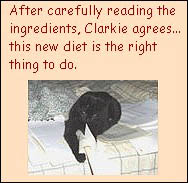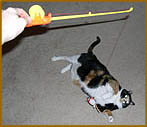Vol1 No25
Table of Contents
Assist Feeding – How Committed are You?
Feline Nutrition – Too Much Of A Good Thing
Pro-Active Cat Care – Good Things To Know
Feline Obesity – Who has any Time for Playtime?
Kitty Potpourri – So Kitty Can’t Hear. Part I
Assist Feeding – How Committed are You?
by Kathy Fatheree
I was reading notes taken from a veterinarian class where they were talking about nutrition and the hospitalized cat. At the end of the class, the following statement was made:
Remember. You are ultimately responsible for the care of your patients.
This statement couldn’t be truer for cats who are being assist fed.
If your kitty is not hospitalized and is being cared for by you, then you are ultimately responsible for the care of your cat. What a strong statement, huh? Are you up for the commitment? You may say “Of course I know that!” or “Of course I’m taking the best care of my cat possible!” or “What choice do I have?”
All good questions, but let’s take a look at what you are committing to.
- Time – Caring for an anorexic cat takes time. lots of time. Each feeding, including preparing the food, can take up to 20 minutes or more. If you feed 4 times a day, you’re looking at 1-½ hours. By the time you clean up the equipment, your cat and yourself, you will be easily devoting 2 hours to the care of your cat. Be prepared for this devotion of time.
- Money – To properly take care of an anorexic cat, you MUST and I repeat MUST take your cat to the vet at least once a month, if not more. An anorexic cat is sick. No matter what the cause, it’s something very strong that requires close monitoring by an expert. This care will require blood work, possible x-rays, sonograms, etc. Be willing to cut your personal spending and possibly take on extra work to pay for your vet bills.
- Energy – I’ve heard people say that assist feeding a cat is like caring for a baby. Feedings 4 times a day, washing towels everyday, washing dishes and special equipment. Besides getting enough rest, you will also need to have emotional energy. Not every feeding goes well. sometimes kitty might throw up all the food and if you are not strong, you may just break down and cry. Your cat may see this as disappointment towards him or her and you can never let your cat feel bad about a feeding. Kitty feels bad enough I’m sure.
- Determination – A kitty cannot go long without the proper amount of food. If your cat eats less food than required each day, whatever is causing the anorexia is going to get worse. Additionally, new detrimental health conditions will arise from malnutrition. You will not see the new health problems growing, but they are looming in the near distance when a cat starts losing weight. If you can’t get the proper amount of food in your cat. admit it. and ask. beg for help. And Fast.
- Love – Assist feeding is most often a stressful event for your cat. Spend plenty of quality time with your cat. Since you are already devoting 2 hours a day to assist feeding, you will need to carve out even more time for quality time. After a feeding, allow your cat to rest, and then spend time petting, grooming, reading together, sleeping together with time to awaken and cuddle and pet, spend time sitting on a porch together watching birds or listening to crickets. however your kitty treasures the time with you.
Yes, assist feeding takes time, money, energy and determination. but this is all done out of LOVE.
When you brought your kitty into your life, knowingly or not, you made a commitment to this precious creature. It is your ultimate responsibility to do what it takes to provide the ultimate care for your cat.
How Committed are You?
Feline Nutrition – Too Much Of A Good Thing
by Garry White
Recently, I investigated a particular cat-food company, and was highly impressed with its holistic/natural products.
But you know me.ever wary.
Anyway.as I got more deeply involved in these new products (foods and supplements), the benefits were immediately obvious. And so were the potential dangers. This company takes the holistic (whole-body) approach to nutrition, whereby the focus is on treating the cause of potential problems in advance, not the symptoms after a crash. Thus, they offer foods that are designed to manage all of a cat’s systems and organs perhaps more effectively than some commercial foods, and they offer a range of supplements. I just used the term “potential dangers”, and this is where it came from; supplements. While these supplements are, indeed, impressive in their makeup, they are also highly concentrated, with very specific nutritional goals. Meaning: They’ll probably do great things for a kitty, but we have to follow instructions to the letter! Mentally, I see these supplements akin to medications, even though the ingredients are purely organic and natural. Mind you, there are a number of companies who offer holistic/natural foods, and this is just one of them. However, being more in the know about this concept now, I have to assume the same logic applies: General foods and specific supplements to complement the foods. And I have to assume those supplements are concentrated, in most cases. If we choose to follow this path, we must be absolutely certain of the amounts we’re suppose to be feeding. For example: This particular company offers a supplement that comes in the form of a patty, not unlike a hamburger patty. The maximum amount to feed a 50-pound dog is not more than ¼ of a patty daily! Great stuff, but you can see how careful we must be in feeding this to 8-pound Fluffy. Another goodie dictates about a teaspoon a day, which must be activated only by moisture. Yet another supplement requires feeding it to the cat 15-20 minutes before mealtime. Still another requires that you feed the kitty a scrap no bigger than a fingernail, and only infrequently, at that!
So we can see, here, that proper administration will probably render good results, while lack of attention can take us where we surely do not want to go.
I ring this (caution?) out to all of you, loud and clear, because it’s not something we have to deal with in commercial foods; I’ve not yet heard of a Friskie’s overdose. Again, if we choose to take the pure-food road to nutrition, we must also observe the inherent, potential pitfalls that come along for the ride. So after all these warnings, am I afraid? Nope. I fully intend to have Dear Clarkie and Goofy Wilbur munching this stuff soon, but you can bet your Lamborghini that I’ll follow the recommended feeding procedures.

ProActive Cat Care – Good Things To Know
by Garry White
- Cats sleep about 66% of the time. By instinct, cats normally sleep in that narrow band of semi-awareness just south of consciousness, but cats can also fall into deep slumber, like us, and are subject to similar brain-wave patterns.dreams. So the twitching we often see (while they sleep) could easily mean she’s about to capture that bird.wish her luck. If an older cat begins to sleep less, it could be due to a condition called hyperthyroidism.be alert for this sign.
- You’ve seen your kitty smell something, and then the mouth opens, the lips curl, and he falls into a trance-like state. It’s not a trance. He’s capturing the scent and transferring it to a small organ called Jacobsen’s organ, technically known as the vomeronasal organ, located high in the roof of the mouth. It’s the cat’s second means of smelling, and this odd behavior is called the “flehmen reaction”, or just “flehming”.
- The normal body-temperature range for an average, healthy cat is 100-103 degrees F.
- Rubbing against furniture is a cat’s way of letting the rest of the feline world know of its presence. Cats have scent glands in several places on their body, including the face and the feet, and this “rubbing” transfers their scent, which contains molecules called pheromones. With un-neutered male cats, spraying is an even better way of telling other kitties to scram, and there’s a product called Feliway that’s supposedly pretty good for discouraging this habit. So now you know that scratching isn’t about “sharpening claws”, it’s about leaving a scent.
- Can be toxic to Kitty: Coffee, tea, chocolate, Macadamia nuts, grapes/raisins, some animal fats, citrus juice, too much liver, garlic, onions, rhubarb and tomato leaves, raw eggs, yeast dough. And marijuana.
- A cat’s hearing is perhaps one of its most amazing attributes. They can hear twice as well as us, and their audible frequency range is nearly twice that of humans. Cats can also distinguish the difference between sounds that are several feet away, and yet only a few inches apart. So when Kitty is sound asleep while you work in the kitchen, yet pops instantly awake when you touch the cabinet door where her food is stored.it’s no mystery; she knows the sound of that door specifically.
- Why do cats groom themselves more in hot weather? Cats do not sweat, as we do. Instead, they rely on the saliva evaporating from their body to create a cooling effect.
- High-Rise Syndrome: If you live in a high-rise apartment or condo, be sure that your kitty cannot fall from landings and decks. It’s true that a cat’s sense of vertigo is more acute than ours, and that their reaction time is faster than in humans, so it’s logical that they can “upright” themselves faster if the distance is only a few feet. Beyond that, it’s purely a myth that cats always land on their feet.
- Did you know: Pound-for-pound, the domestic house cat reputedly has the potential to be more ferocious than any North American animal in its size-range, with exception to the Wolverine.

Feline Obesity – Who has any Time for Playtime?
by Kathy Fatheree
Can you relate to my daily scenario?
I get up in the morning. feed the cats. clean the litter boxes. check my email. get ready for work. and fly out the door. Yes. in that order! Oh, I forgot to eat! Oh well.
When I get home, I feed the cats. clean the litter boxes… check email . and sit down at the computer to work on more work!
When do I have time to play with a cat that doesn’t want to play?
Sound familiar?
 Well, a friend of mine asked the other day “So how is the activity level going with that fat cat of yours?”
Well, a friend of mine asked the other day “So how is the activity level going with that fat cat of yours?”
Embarrassed and feeling guilty I said “Not so good.”
So. knowing that I must play more with Phoebe, I went to the pet store looking for a cat fishing pole. I’ve secretly always wanted one! This is a cheap little thing and it won’t last very long. but let me tell you the reaction to this new toy! As soon as I started opening the cellophane, Phoebe was there wondering what I had. Somehow, she knew it was for her! Oh and the little mouse on the end is so cute! As soon I lowered my line, Phoebe started to play. Just a little right at the beginning. but then as usual.. that was it. All done. So I sat back down at the computer and got back to work. BUT every once in a while, I picked up the fishing rod and dangled the mouse in front of her nose and she would bat at  it! Now whenever she starts to look too relaxed, I pick up the pole (still seated at my desk) and taunt her with it! Of course she whines like I’m bugging her. but then all of a sudden . pow.she attacks the mouse!
it! Now whenever she starts to look too relaxed, I pick up the pole (still seated at my desk) and taunt her with it! Of course she whines like I’m bugging her. but then all of a sudden . pow.she attacks the mouse!
So this is a start! Even a small start is better than none! And Phoebe LOVES the attention. Each time I lower the mouse or sneak it by her in jerky little motions, I make sound effects and I laugh when she attacks it. These extra little touches let her know that this is our special playtime. (And by the way. the office door is closed and it’s driving Nicholas crazy!)
Kitty Potpourri – So Kitty Can’t Hear. Part I
by Dan Malenski
This week, and the next, we will be talking about the deaf cat, and focus on what you must do as a cat’s guardian in order to help kitty copy with the disability. At risk of being politically incorrect, I will continue to use the term deaf instead of the alternative, “aurally challenged”, as long as no one will turn me in to the authorities! My original intention was to focus on living arrangements, but after discussing the outline with the girls in a somewhat raucous conversation, I agreed to make some modifications. Amanda made the point that limiting the medical reason for hearing loss to one paragraph or less is a good idea, but added that we should all know how to determine if a cat is deaf or not ourselves because a hearing test is not typically part of a routine examination. A new cat is unlikely to be tagged or labeled as hearing impaired! Thus, in this week, we will list a few of the medical reasons for hearing loss and spend the remainder on telling you how you can test kitty for hearing ability without having to raid your piggy bank with just a few at home tests.
Many cats are born deaf, and research confirms that hearing loss at birth or shortly thereafter is the result of a genetic defect that results in the cat’s auditory nerves being irreparably damages. Deafness could also occur later in life from many other reasons, such as physical injury, drug interactions, or long-term infections or ear mite infestations. The deaf cat typically compensates with other senses, but you must also assume an active role in helping kitty cope, which is why it is so important that you know about kitty’s condition.
When bringing kitty home for the first time, whether from a shelter or another home, you may not know how well kitty can hear, if at all, and your vet likely will not evaluate kitty’s hearing unless you ask. Consequently, it will be up to you to detect signs that kitty may not be able to hear and conduct some simple tests to verify your suspicions.
If you have reason to doubt your cat’s hearing ability, performing the tests below will help you decide if you need to ask your vet to evaluate kitty’s hearing. Be sure to look for a reaction the first time that you perform a test to prevent kitty from recognizing a sound and just not choosing to respond.
- Tear a piece of paper behind kitty’s head without touching it.
- Crackle a wad of tinfoil or shake a bunch of keys to test high frequency hearing.
- Test low frequency hearing by drumming on a cardboard box.
- Make a hissing sound yourself, and be sure that it cannot feel your breath.
- Run a vacuum cleaner in the same room. A totally deaf cat will not react at all, while any other cats in the room will vanish into the woodwork!
With the exception of running the vacuum cleaner, do not allow kitty to see you making the noise.
If you are able to see a distinct reaction in kitty to all of the above tests, you may feel comfortable that your kitty is not impaired or deaf. However, if any of the reactions you observe leave you with any doubts, you may then ask your vet to perform tests that are more advanced.
Next week, we will talk about what you must do in order to insure a comfortable and safe environment for a kitty that was found to be hearing impaired or deaf.
Note: Information for the tests was extracted from an article written by David Brinicombe, a breeder of Maine Coon cats in the UK.
Disclaimer: Kathy Fatheree is not at all a medical expert. Contents of this web site are a collection of Kathy’s assist feeding experiences as well as the experiences of other cat owners who have assist fed their cats. While every effort has been made to ensure the accuracy of the information, Kathy Fatheree or anyone associated with this web site cannot be held responsible for anything that may happen as a result of using the information on this site.
